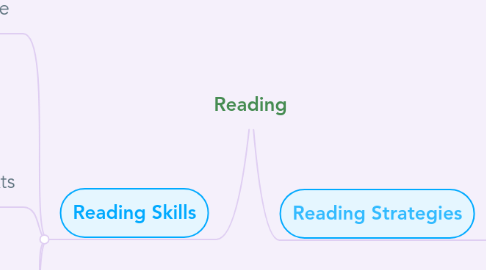
1. Reading Skills
1.1. Reading under pressure
1.1.1. • Decide how long you need to spend on each task.
1.1.2. • Read the questions and decide what strategies you need to answer them.
1.1.3. • If you have difficulty with a question, don’t spend too long on it. Move on to the next one – you can always go back to it later.
1.1.4. • Don’t leave a question unanswered – guess the answer!
1.2. Dealing with new words in texts
1.2.1. • Ignore words that you don’t need to know to understand the text.
1.2.2. • Try to guess the meaning of the important words. Work out the part of speech and use the context to help you guess meaning.
1.2.3. If the word is similar in your language, it possibly means the same but check the context to see if the meaning fits.
1.3. Prediction
1.3.1. • Before you read the text, look at the title and any photos or drawings.
1.3.2. • Read the first few lines of the text. Guess what kind of text it is.
1.4. Inference or ‘reading between the lines’
1.4.1. • Read the question and identify the important words.
1.4.2. • Find the relevant part in the text.
1.4.3. • Find the most important words and expressions in that part of the text.
1.4.4. • Decide if the important words in the question and text express the same idea.
2. Reading Strategies
2.1. Matching headings and paragraphs
2.1.1. • Read each paragraph carefully. Underline 3-5 of the most important words.
2.1.2. • Be careful – the first sentence in a paragraph often introduces the main idea – but not always!
2.1.3. • Read the headings and match them with the paragraphs. They often contain a word or a synonym of a word from the paragraph.
2.1.4. • Check that the extra heading does not match any of the paragraphs.
2.2. Answering True/False/NS information questions
2.2.1. • First read the text to get the general idea
2.2.2. • Then read the questions/statements and identify important words.
2.2.3. • Find the relevant part of the text and identify the important words.
2.2.4. • Decide if the important words in the question/statement and text express the same ideas.
2.2.5. • To decide if there is no information, make sure that the answer (true/false) cannot be inferred from the text. Also make sure that you base your decision only on the information in the text.
2.3. Texts Texts with paragraph gaps
2.3.1. • Read a paragraph with a sentence gap and identify the topic.
2.3.2. • Read the sentences before and after the gap and look for clues about the missing sentence.
2.3.3. • Certain words may help you: time references, pronoun references, linking words.
2.3.4. • Decide which sentence goes in the gap. Check that it fits the sentence before and after it.
2.4. Completing texts with sentence gaps
2.4.1. • Read the text to get the general idea.
2.4.2. • Read a paragraph with a sentence gap and identify the topic.
2.4.3. • Read the sentences before and after the gap and look for clues about the missing sentence.
2.4.4. • Certain words may help you: time references, pronoun references, linking words.
2.4.5. • Decide which sentence goes in the gap. Check that it fits the sentence before and after it.

